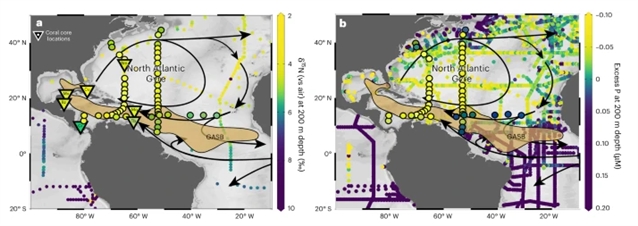
近日,德国马克斯普朗克化学研究所Martnez-Garca, Alfredo团队揭示了赤道磷上升流驱动大西洋氮固定和马尾藻华。2025年11月5日出版的《自然—地球科学》杂志发表了这一最新研究成果。
巨大的大西洋马尾藻带于2011年首次出现,并迅速成为地球上最大的互联浮动生物群落。近年来,马尾藻搁浅事件对沿海社区产生了重大的生态和社会经济影响。马尾藻的生长既需要磷(P)也需要氮(N),但这些营养物质的主要来源仍不清楚,这些营养物质促使马尾藻大量繁殖。
研究组以珊瑚结合的N同位素为主题,重建了过去120年来整个加勒比地区海洋生物可利用N的最终强度- N2固定。他们的数据表明,氮固定的变化主要受赤道大西洋上升流的“过量P”(即相对于固定N的化学计量过量P)的多年代际变化控制。研究组表明,自2011年以来,赤道上升流提供的过量P和N2固定响应中的N可以解释马尾藻的大部分变化。马尾藻动力学最好的解释是其与固氮附生植物的共生关系,这使得大型藻类在过量磷的强烈赤道上升流期间具有很强的竞争力。因此,马尾藻在热带大西洋的未来将取决于全球变暖如何影响赤道大西洋上升流以及控制它的气候模式。
附:英文原文
Title: Equatorial upwelling of phosphorus drives Atlantic N2 fixation and Sargassum blooms
Author: Jung, Jonathan, Duprey, Nicolas N., Foreman, Alan D., DOlivo, Juan Pablo, Pellio, Carolin, Ryu, Yeongjun, Murphy, Erin L., Romshoo, Baseerat, Kersting, Diego K., Cardoso, Gabriel O., Wald, Tanja, Fripiat, Franois, Jimenez, Carlos, Gischler, Eberhard, Montagna, Paolo, Alonso-Hernndez, Carlos, Gomez-Batista, Miguel, Treinen-Crespo, Christina, Carriquiry, Jos, Ong, Maria Rosabelle, Goodkin, Nathalie F., Guppy, Reia, Aardema, Hedy, Slagter, Hans, Heins, Lena, de Angelis, Isabella Hrabe, Bieler, Aaron L., Yehudai, Maayan, Nol, Trevor P., James, Kendon, Scholz, Denis, Hu, Chuanmin, Barnes, Brian B., Pozzer, Andrea, Phlker, Christopher, Lelieveld, Jos, Pschl, Ulrich, Vonhof, Hubert, Haug, Gerald H., Schiebel, Ralf, Sigman, Daniel M., Martnez-Garca, Alfredo
Issue&Volume: 2025-11-05
Abstract: The Great Atlantic Sargassum Belt first appeared in 2011 and quickly became the largest interconnected floating biome on Earth. In recent years, Sargassum stranding events have caused substantial ecological and socio-economic impacts in coastal communities. Sargassum requires both phosphorus (P) and nitrogen (N) for growth, yet the primary sources of these nutrients fuelling the extensive Sargassum blooms remain unclear. Here we use coral-bound N isotopes to reconstruct N2 fixation, the ultimate source of the ocean’s bioavailable N, across the Caribbean over the past 120 years. Our data indicate that changes in N2 fixation were primarily controlled by multidecadal and interannual changes in equatorial Atlantic upwelling of ‘excess P’, that is, P in stoichiometric excess relative to fixed N. We show that the supply of excess P from equatorial upwelling and N from the N2 fixation response can account for the majority of Sargassum variability since 2011. Sargassum dynamics are best explained by their symbiosis with N2-fixing epiphytes, which render the macroalgae highly competitive during strong equatorial upwelling of excess P. Thus, the future of Sargassum in the tropical Atlantic will depend on how global warming affects equatorial Atlantic upwelling and the climatic modes that control it.
DOI: 10.1038/s41561-025-01812-2
Source: https://www.nature.com/articles/s41561-025-01812-2
